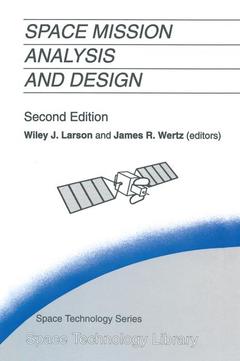Description
Space Mission Analysis and Design (2nd Ed., 2nd ed. 1992. Softcover reprint of the original 2nd ed. 1992)
Space Technology Library Series, Vol. 2
Coordinators: Larson Wiley J., Wertz A.V.
Language: English
Subject for Space Mission Analysis and Design:
Publication date: 10-2013
878 p. · 16x24 cm · Paperback
878 p. · 16x24 cm · Paperback
Description
/li>Contents
/li>
With the second edition of Space Mission Analysis and Design, two changes have been introduced in the Space Technology Library. Foremost among these is the intro duction of the Space Technology Series as a part of the Space Technology Library. Dr. Wiley Larson of the US Air Force Academy and University of Colorado, Colorado Springs, will serve as Managing Editor for the Space Technology Series. This series is a cooperative effort of the Department of Defense, National Aeronautics and Space Administration, Department of Energy, and European Space Agency, coor dinated by the US Air Force Academy. The sponsors intend to bring a number of books into the series to improve the literature base in the fundamentals of space technology, beginning with the current volume. Books which are not a part of the Space Technology Series, but which also represent a substantial contribution to the space technology literature, will still be published in the Space Technology Library. As always, we welcomesuggestions and contributions from the aerospace com munity.
1. The Space Mission Analysis and Design Process.- 1.1 Introduction and Overview.- 1.2 The Space Mission Life Cycle.- 1.3 Definition of Mission Objectives.- 1.4 Preliminary Estimate of Mission Needs, Requirements, and Constraints.- 2. Mission Characterization.- 2.1 Identifying Alternative Mission Concepts.- 2.2 Identifying Alternative Mission Architectures.- 2.3 Identifying System Drivers.- 2.4 Characterizing the Mission Architecture.- 3. Mission Evaluation.- 3.1 Identification of Driving Requirements.- 3.2 Mission Analysis.- 3.3 Mission Utility.- 3.4 Mission Concept Selection.- 4. Requirements Definition.- 4.1 Role of Requirements in System Development.- 4.2 Requirements Analysis and Performance Budgeting.- 4.3 Requirements Specification.- 4.4 Summary: The Steps to a Requirements Baseline.- 5. Space Mission Geometry.- 5.1 Introduction to Geometry on the Celestial Sphere.- 5.2 Earth Geometry Viewed from Space.- 5.3 Apparent Motion of Satellites for an Observer on the Earth.- 5.4 Development of Mapping and Pointing Budgets.- 6. Introduction to Astrodynamics.- 6.1 Keplerian Orbits.- 6.2 Orbit Perturbations.- 6.3 Orbit Maneuvering.- 6.4 Launch Windows.- 6.5 Orbit Maintenance.- 7. Orbit and Constellation Design.- 7.1 The Orbit Design Process.- 7.2 Earth Coverage.- 7.3 The Delta-V Budget.- 7.4 Selecting Orbits for Earth-Referenced Spacecraft.- 7.5 Selecting Transfer, Parking, and Space-Referenced Orbits.- 7.6 Constellation Design.- 8. The Space Environment and Survivability.- 8.1 The Space Environment.- 8.2 Hardness and Survivability Requirements.- 9. Defining and Sizing Space Payloads.- 9.1 Types of Payloads.- 9.2 Overview of Payload Design and Sizing.- 9.3 Subject Trades.- 9.4 Overview of Observation Payloads.- 9.5 Designing Visual and IR Payloads.- 9.6 Payload Sizing.- 9.7 The FireSat Payload.- 10. Spacecraft Design and Sizing.- 10.1 Requirements, Constraints, and the Design Process.- 10.2 Spacecraft Configuration.- 10.3 Design Budgets.- 10.4 Designing the SpacecraftBus.- 10.5 Integrating the Spacecraft Design.- 10.6 Examples.- 11. Spacecraft Subsystems.- 11.1 Attitude Determination and Control.- 11.2 Communications.- 11.3 Command and Data Handling.- 11.4 Power.- 11.5 Thermal.- 11.6 Structures and Mechanisms.- 11.7 Guidance and Navigation.- 12. Spacecraft Manufacture and Test.- 12.1 Engineering Data.- 12.2 Manufacture of High-Reliability Hardware.- 12.3 Inspection and Quality Assurance.- 12.4 The Qualification Program.- 12.5 Spacecraft Qualification Test Flow.- 12.6 Launch Site Operations.- 13. Communications Architecture.- 13.1 Communications Architecture.- 13.2 Data Rates.- 13.3 Link Design.- 13.4 Sizing the Payload.- 13.5 Special Topics.- 14. Mission Operations.- 14.1 Overview of Mission Operations.- 14.2 Spacecraft Operations.- 14.3 Personnel Training.- 14.4 Mission Planning.- 14.5 Engineering Support.- 15. Ground System Design and Sizing.- 15.1 The Ground System Design Process.- 15.2 A Ground System’s Basic Elements.- 15.3 The Typical GroundSystem.- 15.4 Alternatives To Building a Dedicated System.- 15.5 Key Design Considerations.- 16. Spacecraft Computer Systems.- 16.1 Allocating Requirements.- 16.2 Computer Resource Estimation.- 16.3 Development, Test, and Integration.- 17. Space Propulsion Systems.- 17.1 Propulsion Subsystem Selection and Sizing.- 17.2 Basics of Rocket Propulsion.- 17.3 Types of Rockets.- 17.4 Component Selection and Sizing.- 17.5 Staging.- 18. Launch Systems.- 18.1 Basic Launch Vehicle Considerations.- 18.2 Launch System Selection Process.- 18.3 Determining the Spacecraft Design Envelope and Environments.- 19. Space Logistics and Reliability.- 19.1 Space Logistics.- 19.2 Reliability During Space Mission Concept Exploration.- 20. Cost Modeling.- 20.1 Introduction to Cost Analysis.- 20.2 The Parametric Cost Estimation Process.- 20.3 Cost Estimating Relationships.- 20.4 Other Topics.- 20.5 FireSat Example.- 21. Limits on Mission Design.- 21.1 Law and Policy Considerations.- 21.2 Orbital Debris—A Man-madeHazard.- 22. Design of Low-Cost Spacecraft.- 22.1 Designing Low-Cost Space Systems.- 22.2 Small Space Systems Capabilities and Applications.- 22.3 Applying Miniature Satellite Technology to FireSat.- 22.4 Scaling from Large to Small Systems.- 22.5 Economics of Low-Cost Space Systems.- 22.6 Annotated Bibliography on Low-Cost Space Systems.- Epilogue. Applying Space Mission Analysis and Design.- E.1 Applying SMAD to Later Mission Phases.- E.2 Lessons Learned from Existing Space Programs.- E.3 Future Trends.- Appendix A. Mass Distribution for Selected Satellites.- Appendix B. Astronautical and Astrophysical Data.- Appendix C. Standard Notation.- Appendix D. Spherical Geometry Formulas.- Appendix E. Units and Conversion Factors.- Spaceflight Formulas.- Fundamental Physical Constants.- Spaceflight Constants.- Index to Process Tables.- Earth Satellite Parameters.
© 2024 LAVOISIER S.A.S.

